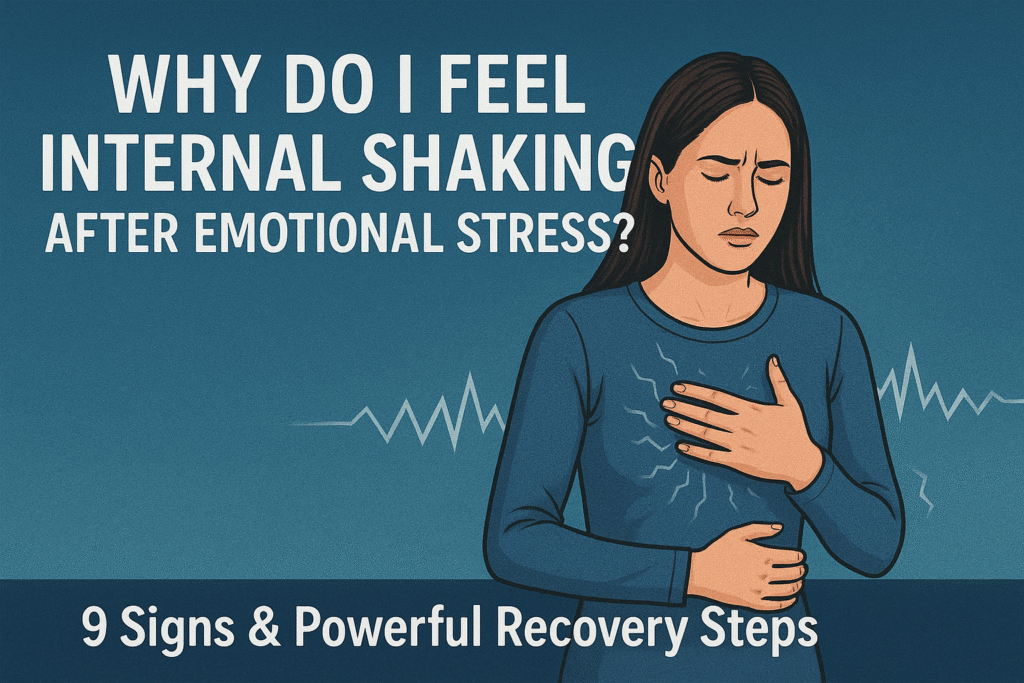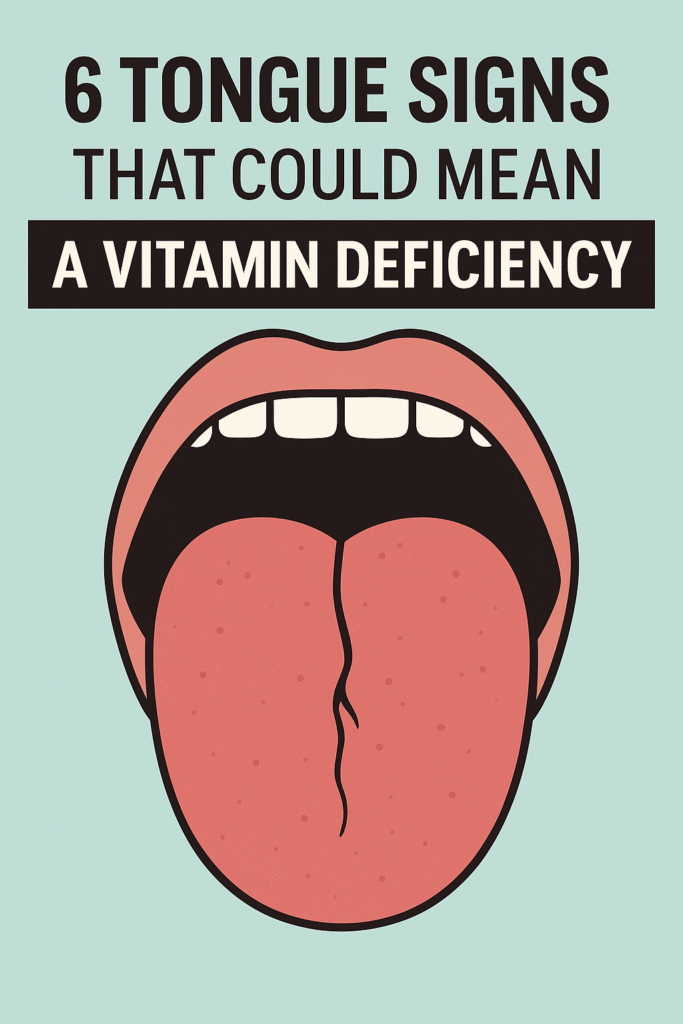Why Do I Feel Internal Shaking After Emotional Stress?
Ever walked away from an argument or emotional moment only to feel your body buzzing from the inside, as if something’s trembling beneath your skin, even though you’re completely still? That quiet internal shaking can be unnerving. You look calm, but inside, it feels like your nerves are vibrating.
Here’s the truth, you’re not imagining it and you’re not weak. That inner trembling is your body’s way of releasing emotional tension, a physiological reset after stress overload. In this article, we’ll break down what’s actually happening beneath the surface, when emotions push your nervous system into overdrive and how to help your body return to calm.

What “Internal Shaking” Actually Feels Like
People describe it in different ways:
- A vibrating or buzzing feeling inside the chest, arms or legs.
- A faint tremor in the core that others can’t see.
- A sensation of your heart or muscles trembling without visible movement.
- Feeling “wired,” jumpy or unsteady, even when sitting still.
For some, it lasts a few minutes, for others, it can linger for hours or even days after the emotional trigger. Although it feels alarming, internal shaking after stress is a physiological response, not a sign that you’re “going crazy”. To understand it, you need to look at how the body reacts to emotional intensity.
1. The Nervous System’s Stress Reflex
Your body has two major branches of the autonomic nervous system (ANS):
- Sympathetic nervous system (SNS): activates your “fight, flight, or freeze” response.
- Parasympathetic nervous system (PNS): helps your body relax, digest, and recover.
When you experience emotional stress, the sympathetic system surges into action. Adrenaline and noradrenaline flood your bloodstream, raising heart rate, tightening muscles, and sharpening focus.
This survival mode is powerful but it’s meant to be temporary. Once the stressor ends, your parasympathetic system should step in to calm you down. However, if the stress was intense or prolonged, your body doesn’t always switch off smoothly. That’s when internal shaking shows up, a sign that your nervous system is discharging excess energy or struggling to return to baseline.
2. The Adrenaline Dump: Why You Tremble Inside
Adrenaline doesn’t just cause your heart to race, it also activates your muscles and nerves. When the surge fades, your body needs to release that leftover tension.
That release often appears as trembling or shaking, either visible or internal. Think of how animals shake after escaping a threat, it’s the body’s built-in way of resetting the stress cycle.
For humans, internal shaking is that same biological process, but subtler. Instead of shaking visibly, your muscles and nerves quiver microscopically as they burn off adrenaline and restore balance.
This can happen:
- After an argument or traumatic conversation
- After public speaking, a performance, or high-stakes meeting
- Following a panic attack or intense fear
- Even after you’ve mentally moved on from an event, because your body hasn’t yet
In short, your body remembers the stress, even when your mind thinks it’s over.
3. The Role of Cortisol and Prolonged Stress
If the shaking doesn’t resolve quickly. Cortisol, your main stress hormone may be keeping your system in a state of high alert. Chronic emotional stress elevates cortisol levels, which can:
- Keep muscles tense
- Disrupt sleep and recovery
- Sensitize the nervous system, making you feel trembly or “wired”
- Increase anxiety or panic-like sensations
When your cortisol rhythm stays high for too long, your nervous system gets stuck between “on” and “off”. You’re not fully relaxed, but not in full panic mode either, a shaky, restless in-between state that feels like internal vibration.
4. Emotional Energy and the Freeze Response
Some people don’t fight or flee when overwhelmed, they freeze. This is another survival reflex where the body temporarily shuts down to protect itself. After a freeze response, the body often tries to thaw out. Trembling or internal shaking is part of that thaw, a neuromuscular discharge that releases trapped energy from the freeze state.
This is why some trauma survivors or people with chronic anxiety experience internal tremors long after the event. Their nervous system keeps trying to complete the stress cycle that was interrupted.
5. The Vagus Nerve Connection
The vagus nerve, the body’s longest cranial nerve plays a major role in calming you after stress. It controls heart rate, digestion, and other parasympathetic functions. When the vagus nerve is underactive or dysregulated (common in people with anxiety, trauma history, or chronic stress), your body may struggle to activate the “rest and digest” mode effectively.
Signs of vagus nerve imbalance include:
- Internal shaking or vibration sensations
- Heart palpitations or fluttering
- Tightness in the chest or throat
- Dizziness or lightheadedness
- Digestive changes after stress
Improving vagal tone, through breathing, humming or cold exposure can help reduce these internal tremors over time.
6. When Internal Shaking Is Linked to Anxiety
If you often feel internal trembling during or after emotional stress, anxiety is a likely factor. Anxiety isn’t just mental, it’s deeply physiological. When your brain perceives threat (even emotional), it floods your system with excitatory neurotransmitters like norepinephrine and glutamate. This overactivation can cause:
- Micro-tremors in muscles
- Tingling or buzzing under the skin
- Feeling “on edge” or overstimulated
- Difficulty sleeping or focusing
Even after the anxiety passes, your nervous system may stay hypersensitive, leading to post-stress shaking that can persist for hours or days. This doesn’t mean you’re developing a neurological disease. It’s your body expressing emotional overload through physical channels.
7. Neurological and Hormonal Links
Sometimes, internal shaking can also be influenced by neurological or hormonal factors that amplify your stress response.
- Low blood sugar: Drops in glucose can mimic adrenaline effects, jitteriness, sweating, internal tremors.
- Thyroid imbalance (especially hyperthyroidism): Overactive thyroid hormones can make your body overreact to emotional stress.
- Perimenopause or menopause: Hormonal shifts affect the nervous system’s stability, often producing tremors or internal vibrations.
- Vitamin or mineral deficiencies, especially magnesium or B vitamins, can worsen muscle excitability.
If your internal shaking occurs frequently and not just after stress, it’s worth checking these medical factors with your doctor.
8. The Mind-Body Connection: Why You Can’t “Think It Away”
You can’t simply “mentally control” internal shaking because it’s not a thought-based issue. It’s rooted in your autonomic physiology, the part of your body that operates automatically.
However, your mind and body are intertwined. Persistent emotional stress, suppressed feelings, or chronic overthinking keep your nervous system in a low-grade defensive mode. Over time, that becomes your baseline. Many people describe feeling fine mentally but physically wired, an internal buzz that never quite goes away. This mismatch means your body hasn’t yet caught up with your conscious calm.
Learning to regulate your body’s state directly, not just through logic or reassurance is key to breaking this cycle.
How to Calm Internal Shaking After Emotional Stress
You can’t avoid emotional stress entirely, but you can train your body to recover faster when it happens. Here’s how:
1. Ground Yourself Physically
Bring your awareness back to your body and surroundings.
- Press your feet firmly into the ground.
- Notice sensations, texture, temperature, weight.
- Move your body slowly (roll shoulders, stretch arms).
Grounding signals safety to your brain and helps switch off the stress reflex.
2. Use Controlled Breathing
Your breath is a direct pathway to the nervous system. Slow, deep breathing stimulates the vagus nerve and reduces internal tremors.
Try the 4-7-8 technique:
- Inhale through your nose for 4 seconds.
- Hold for 7 seconds.
- Exhale gently through your mouth for 8 seconds.
Repeat for a few minutes. The longer exhale activates your parasympathetic system and helps your body settle.
3. Allow the Trembling
If you feel your body tremble, don’t fight it. Controlled shaking (as seen in trauma release exercises, or TRE) can help your body complete the stress cycle naturally.Find a private space, lie down or sit comfortably, and let your body shake lightly until it subsides. It may feel strange, but it’s a healthy physiological release not something to suppress.
4. Hydrate and Nourish
Adrenaline and cortisol affect hydration, blood sugar, and electrolytes. Drink water, eat a balanced meal, and consider magnesium-rich foods (like leafy greens or almonds) to relax muscles.
5. Cold Exposure or Splashing Cold Water
Cold activates the vagus nerve and helps calm an overstimulated system. A brief cold shower, or splashing cold water on your face, sends a signal of safety to your brainstem.
6. Gentle Movement
Slow walks, yoga, or stretching help your muscles discharge tension without overstimulation. Movement tells your nervous system that the “threat” has passed.
7. Sleep and Rest
Sleep restores nervous system balance. If shaking lingers, prioritize deep rest, naps, quiet time or early nights to give your body space to repair.
8. Reduce Stimulants
Caffeine, nicotine, and energy drinks amplify internal tremors. After emotional stress, your system is already charged, avoid adding more stimulation.
9. Talk It Out
Emotional suppression can keep the stress loop alive. Talking to a therapist, friend, or counselor helps the mind process what the body is trying to discharge physically.
10. Practice Ongoing Nervous System Regulation
Regular practices that enhance vagal tone such as mindfulness, humming, singing or gentle breathwork train your body to recover faster from emotional stress in the future.
When to Seek Medical Help
Occasional internal shaking after emotional stress is completely normal. It’s often just your body releasing leftover adrenaline or tension, a temporary response that fades as your nervous system resets. However, if this sensation becomes frequent, prolonged or unusually intense, it may be worth checking in with a healthcare provider.
You should consult a doctor if:
- It happens frequently or lasts more than a few hours.
Persistent shaking can indicate that your nervous system is staying in a heightened state too long, possibly due to anxiety disorders, hormonal imbalances, or overstimulation. - It occurs without any clear emotional trigger.
When internal tremors arise “out of nowhere,” it’s important to rule out physical causes such as thyroid dysfunction, electrolyte imbalance, or neurological issues. - It’s accompanied by muscle weakness, visible tremors, or coordination problems.
True motor tremors or muscle weakness may point to conditions that require medical evaluation such as essential tremor, Parkinson’s disease, or medication side effects. - You experience palpitations, dizziness or fainting.
These symptoms suggest that your cardiovascular or autonomic system might be overreacting. In rare cases, they can signal heart rhythm irregularities or postural orthostatic tachycardia syndrome (POTS). - You have ongoing anxiety, trauma symptoms or emotional distress.
If the shaking interferes with your ability to rest, focus, or function normally, it may be a sign that your nervous system is chronically dysregulated. Therapy, medication, or trauma-informed care can help reset it safely.
Your doctor may perform basic investigations such as:
- Thyroid function tests (to rule out hyperthyroidism)
- Blood glucose and electrolyte panels (to detect hypoglycemia or imbalance)
- Neurological exams (to assess tremor patterns and nerve stability)
- Medication reviews (since certain antidepressants, stimulants, or asthma drugs can increase internal tremors)
If no medical condition is found, your provider might recommend stress-reduction strategies or refer you to a therapist specializing in somatic or trauma-informed approaches. The goal isn’t just symptom control, it’s to restore your body’s natural ability to regulate itself.
Recovery Takes Time But It’s Possible
Your body’s internal shaking isn’t a malfunction, it’s a message of recovery in progress. It’s the language of your nervous system saying, “I’ve been through something intense, and I’m working to find balance again”.
This internal trembling often represents the final stage of the stress response, a physical discharge that occurs once your body feels safe enough to release stored tension. Unfortunately, many people misinterpret it as a setback or a sign of instability and instinctively try to suppress it, but pushing it down only traps the residual energy longer, delaying your return to calm.
True recovery happens when you work with your body, not against it. Healing begins when you allow your system to complete what stress interrupted. That process is gradual, but it’s also deeply intelligent and self-correcting when supported.
Here’s what that looks like in practice:
Acceptance Instead of Fear
Recognize that the trembling isn’t danger, it’s detox. It’s your body burning off excess adrenaline and rebalancing hormones after a period of overload. When you accept the shaking rather than resist it, you remove the “second layer” of anxiety that keeps your system activated. Calm curiosity is far more healing than fear or frustration.
Gentle Consistency
Nervous system regulation doesn’t come from one big breakthrough; it’s built through repetition. The more consistently you practice grounding, controlled breathing, gentle movement, and emotional release, the faster your recovery reflex becomes. Over time, those small daily habits reshape your baseline from hyperalert to steady, from reactive to resilient.
Allowing Emotional Completion
Emotional stress doesn’t truly end when the event is over, it ends when your body feels safe again. Crying, shaking, yawning, or sighing are physical signs that your system is completing the stress cycle. Give yourself permission to let those responses happen without judgment. They’re not weakness, they’re biological repair mechanisms at work.
Lifestyle Support
Your nervous system can only regulate itself when it’s well-nourished. Prioritize restorative sleep, hydration, and balanced meals rich in magnesium, omega-3s, and vitamins B, nutrients that calm neural activity. Gentle daily movement, such as walking or stretching, helps metabolize stress hormones, minimize nervous-system irritants like caffeine, alcohol, nicotine, and digital overstimulation, especially in the evenings.
Patience
If your body has been living in a state of hypervigilance for months or years, it won’t unwind instantly. Recovery unfolds in cycles, progress, pause, progress again. The internal shaking will fade gradually as your body relearns how to turn off the stress response. Think of it as teaching your body the sensation of safety, one consistent signal at a time.
Key Takeaway
Internal shaking after emotional stress isn’t random, it’s a predictable neurophysiological reaction that shows your body is actively trying to recover. When adrenaline surges, cortisol rises, and your brain’s emotional centers stay lit, your body needs a physical outlet to discharge that energy. The result is the faint but real vibration you feel inside. Rather than fearing it, view it as evidence of your body’s intelligence. Every tremor, every subtle quiver, is your system saying, “I’m restoring equilibrium.”
The most effective recovery strategy isn’t to suppress or fight the feeling, it’s to guide your nervous system gently back to calm. Breathing exercises, grounding movements, emotional release, and good sleep hygiene are the anchors that help stabilize you. Consistency matters more than intensity, you don’t need drastic interventions, you need repetition, regulation, and reassurance. Over time, your brain learns that safety is the new default, not survival mode.
Bottom Line
Your body isn’t failing you, it’s protecting you. That inner trembling isn’t a breakdown, it’s your nervous system doing its cleanup work after emotional turbulence. It’s the body’s built-in way of saying, “The danger’s over, now I can let go”.
When you stop fighting the sensation and start supporting it with calm breathing, grounded movement, sleep and gentle self-care, the shaking naturally fades. What feels like chaos is actually your physiology re-balancing itself.
So don’t rush the process. Listen to what your body is communicating with patience, trust and consistency, those tremors become less about fear and more about recovery taking shape.
⚠️ Affiliate Disclaimer: This post may contain affiliate links, which means I may earn a small commission — at no extra cost to you — if you make a purchase through one of these links. I only recommend products or services I genuinely trust and believe can provide value. Thank you for supporting My Medical Muse!
Related Post:
- 9 Powerful Reasons Why Your Hands Shake When You Are Not Nervous or Hungry
- 7 Fascinating Reasons Why You Shiver When You’re Not Cold
- Why Do My Hands Swell in the Morning? 9 Surprising Reasons & Simple Fixes
- 7 Key Reasons Why Your Hands Shake Only When You’re Hungry and How to Stop It
- Why Do My Fingers Lock When Bending? 7 Simple Remedies That Work Fast
👩⚕️ Need Personalized Health Advice?
Get expert guidance tailored to your unique health concerns through MuseCare Consult. Our licensed doctors are here to help you understand your symptoms, medications, and lab results—confidentially and affordably.
👉 Book a MuseCare Consult Now

